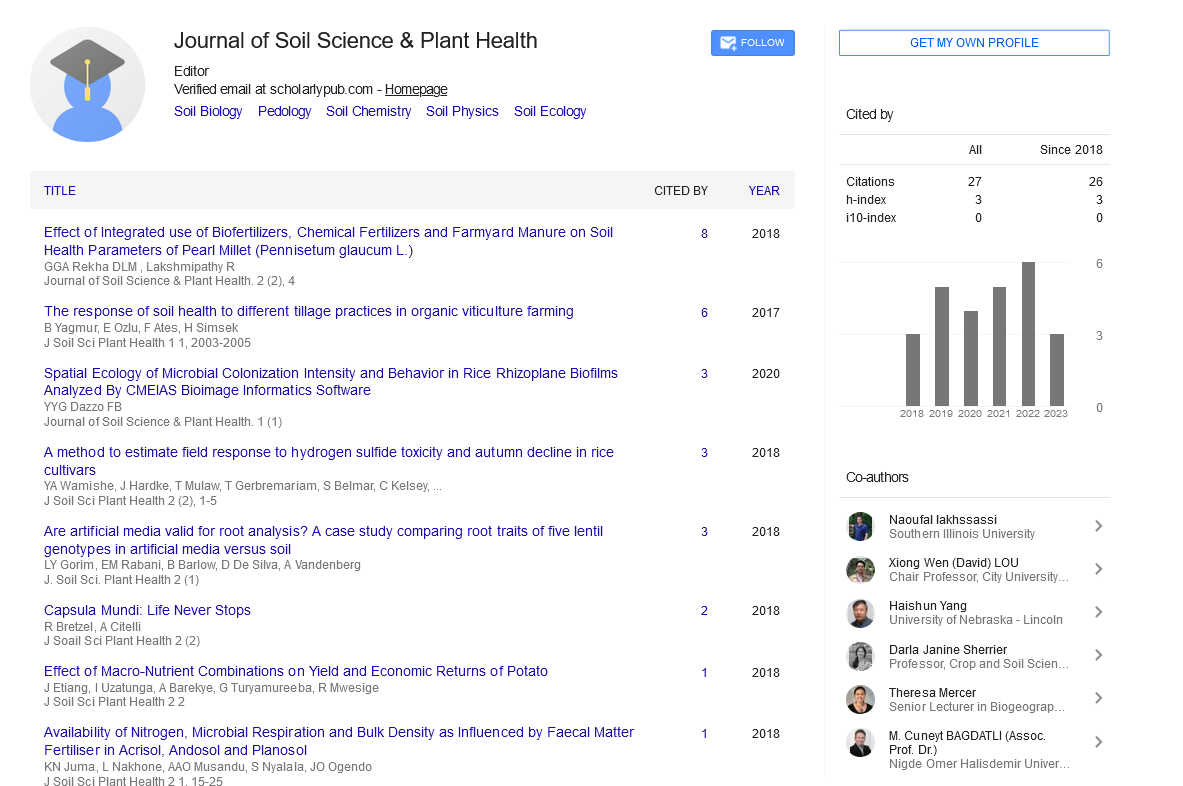Perspective, J Soil Sci Plant Health Vol: 5 Issue: 12
A Brief Note on Sources of Soil Biology
Susan Torreano*
Department of Agricultural Science, University of Toronto, Mexico city, Mexico
*Corresponding author: Dr. Susan Torreano, Department of Agricultural Science, University of Toronto, Mexico city, Mexico, Email: torreano_s@gmail.com
Received date: December 02, 2021; Accepted date: December 16, 2021; Published Date: December 23, 2021
Citation: Susan Torreano (2021) A Brief Note on Sources of Soil Biology. J Soil Sci Plant Health 5:12
Abstract
The purpose of this technical note is to provide information about the effects of land management decisions on the belowground component of the food web. It points out changes in soil biological function that land managers should look for when changing management practices. This information is not a set of prescriptive guidelines, but is designed to increase awareness and prompt field trials.
Keywords: Soil Biology, Manageme, Earthworms
Description
The purpose of this technical note is to provide information about the effects of land management decisions on the belowground component of the food web. It points out changes in soil biological function that land managers should look for when changing management practices. This information is not a set of prescriptive guidelines, but is designed to increase awareness and prompt field trials.
The Goal of Soil Biology Manageme
The goal of managing the soil biological community is to improve biological functions, including forming and stabilizing soil structure, cycling nutrients, controlling pests and disease, and degrading or detoxifying contaminants. Research shows that management practices and disturbances impact soil biological functions because they can 1) enhance or degrade the microbial habitat, 2) add to or remove food resources, or 3) directly add or kill soil organisms. Although management practices are known to impact soil biology, there is limited knowledge to support the development of detailed management strategies. A particular practice may have the desired result in one situation but have little effect in another because biological communities respond to the interaction of multiple factors including food sources, physical habitat, moisture, and impacts of historical land use. Therefore, before a new product or practice is applied to a large parcel of land, it should be tested on a limited area and results should be monitored in comparison to an untreated plot.
Soil biology, size and diversity, is a reflection of the agroecosystem plant diversity, vegetation structure, and management practices. Soil environment, whether in temperate or tropical regions, cropland or grassland, is highly favorable to the microbial community. This trend may be due to better quality and greater abundance of organic matter sources, favorable water conditions, and temperature (Weil and Brady, 2016). Soil invertebrate communities generally are good indicators of soil functionality and soil management effects in response to changes in land use and management practices that include tillage, crop diversity, and a change in vegetation such as the conversion of forestland to row crops (Bongers, 1990). Change in land use differs widely in effects on different microbial communities. However, annual crop production has caused severe depletion of microinvertebrate communities in certain areas, leading to a significant decline in earthworms, such as under rice (Oryza sativa L.), corn (Zea mays L.), beans (Glycine max L.), for a wide range of temperate and tropical environments (Lee, 1985). Yet, there must be an increased emphasis on soil health and agriculture sustainability under annual cropping systems. Thus, it is imperative to determine the effect of row cropping systems, and particularly, the role of crop rotation in maintaining soil function and services. The key property that influences soil health is SOM, which is highly affected by crop rotation (Six et al., 2000; Guzman and Al-Kaisi, 2014; Lal, 2015). Many scientists have reported the positive effect of crop rotations; particularly those which include small grains and legumes, along with CA systems in maintaining or improving SOM (Odell et al., 1984; Campbell et al., 1991). In a row cropping system, the effect of crop rotation on SOC and N fractions and microbial biomass C (MBC) is related to the amount of crop residues returned to the soil (Omay et al., 1997) and root system (Guzman and Al-Kaisi, 2011). Indeed, MBC and microbial biomass N (MBN) can be more under continuous wheat than under wheat-fallow rotations and lower than that under grass pasture (Collins et al., 1992).
 Spanish
Spanish  Chinese
Chinese  Russian
Russian  German
German  French
French  Japanese
Japanese  Portuguese
Portuguese  Hindi
Hindi 